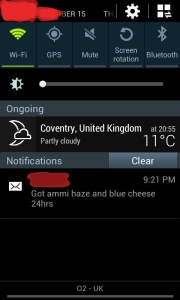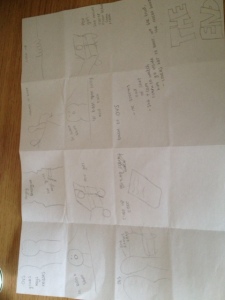As a media producer, ideas are supposed to be bread and butter to us. But ask someone to write a script on the spot without stopping and the narrative becomes diluted and without proper structure. However, ideas flow out of your fingers that you never thought you had. It is then a matter of sieving through these ideas and adding structure.
As a group, we analysed our ideas and came up with an idea based on this two images:
 We were excited about using this first image as it could lead to many different narrative points and left us with a many different ways in which we could create an intriguing story around the image and how the characters got to that frame.
We were excited about using this first image as it could lead to many different narrative points and left us with a many different ways in which we could create an intriguing story around the image and how the characters got to that frame.
 When looking for creative inspiration, the first place you look into your own lives, whether that is literal or the society around you that you often see and perhaps are affected by. One thing we have experienced as a group, not necessarily first hand, is drug culture.
When looking for creative inspiration, the first place you look into your own lives, whether that is literal or the society around you that you often see and perhaps are affected by. One thing we have experienced as a group, not necessarily first hand, is drug culture.
Our second image is this message, received by a friend, from a drug dealer. We decided to incorporate this image into our story due to the slang used in the message. Blue cheese? To most people this wouldn’t initially stand out to them as a drug reference.
When undertaking further research, it became apparent that a number of drugs had nicknames which correlated with food names:
Cocaine – Sugar, Depressants – M&M’s, Heroin – Brown Sugar, Marijuana – Herbs, Mescaline – Beans, MDMA – Disco Biscuits, Opium – Chocolate. Psilocin – Mushrooms. (Staff, 2007)
So, our idea was to play on the fact of people’s lack of knowledge and portray one character as someone who was very aware of the drug culture and another who is hopelessly unaware, mixing up the others drug orders for groceries.
To create comedy around the idea we want to be able to hint at it all throughout through confusion in dialogue and suggestive cinematics. This will be done by giving the audience suggestions by the actor imitating drug takers habits through actions and dialogue. When undertaking research, we found out that anger, paranoia, suspicious behaviour, mood swings and life revolving around drug taking are all common signs of drug addicts. (Narconon – Addiction and Recovery, 2015) (Helpguide.org, 2015)All of these we aim to personify in our actor. This will give the audience the maximum chance of understanding the underlying drug theme without explicitly saying it. Hopefully having the other actors confusion conflicting with the main actors drug obsession and then, at the end, having a grand reveal of the groceries it will be a very gratifying and comedic ending.
To fully be able to create an artifact of the highest quality, we must do some further research into the comedy genre. “There is no single adequate theory of comedy, despite various efforts to produce an all-embracing account. Various different theoretical approaches are available and of differing degrees of use, depending on the precise nature of the comedy involved in any individual case and the different questions we might seek to answer.” (King, 2002). So, we must identify the topic we are trying to tackle so we know what type of comedic approach to take. Whilst we are tackling a topic of drugs, we can repurpose what is not generally seen as a comedic topic to be funny. “Material not intended to be in the realm of comedy can also be re-purposed to comical or partially comical effect…. in a manner that renders it to be absurd”. (King, 2002). So, by making this topic absolutely absurd we can create comedy rather than the usual dramatic sense that drugs are usually seen in.
References
King, G. (2002). Film comedy. London: Wallflower Press. p.5. p.200-201.
Staff, C. (2007). Top 20 Drugs And Their Street Names. [online] Casa Palmera. Available at: https://casapalmera.com/top-20-drugs-and-their-street-names/ [Accessed 24 Oct. 2015].
Narconon – Addiction and Recovery, (2015). The 5 Most Common Behavior Traits of an Addict | Narconon – Addiction and Recovery. [online] Available at: http://www.narconon.org/blog/drug-addiction/5-common-behavior-traits-addict/ [Accessed 25 Oct. 2015].
Helpguide.org, (2015). Drug Abuse and Addiction: Signs, Symptoms, and Help for Drug Problems & Substance Abuse. [online] Available at: http://www.helpguide.org/articles/addiction/drug-abuse-and-addiction.htm [Accessed 24 Oct. 2015].




 We were excited about using this first image as it could lead to many different narrative points and left us with a many different ways in which we could create an intriguing story around the image and how the characters got to that frame.
We were excited about using this first image as it could lead to many different narrative points and left us with a many different ways in which we could create an intriguing story around the image and how the characters got to that frame. When looking for creative inspiration, the first place you look into your own lives, whether that is literal or the society around you that you often see and perhaps are affected by. One thing we have experienced as a group, not necessarily first hand, is drug culture.
When looking for creative inspiration, the first place you look into your own lives, whether that is literal or the society around you that you often see and perhaps are affected by. One thing we have experienced as a group, not necessarily first hand, is drug culture.